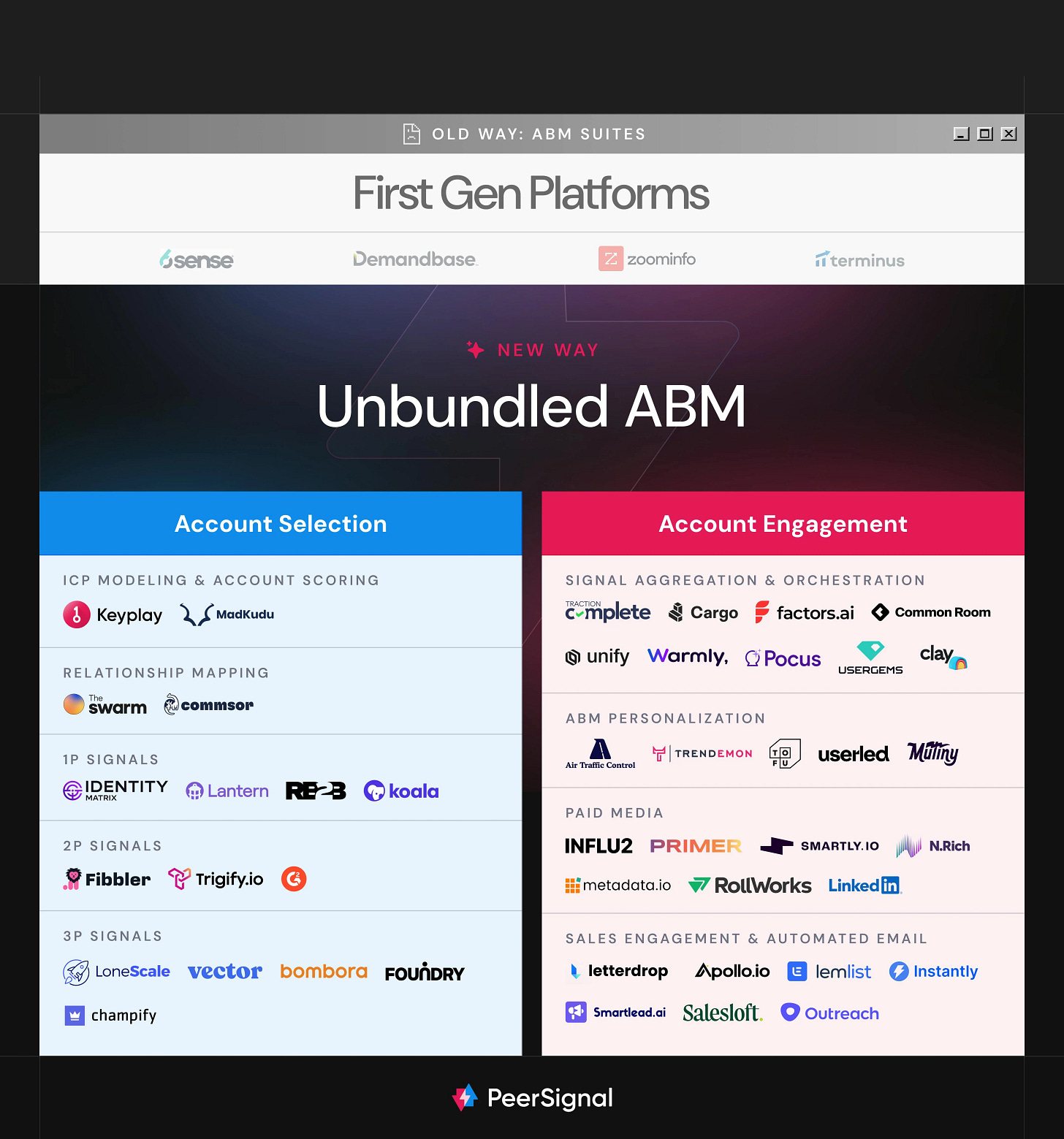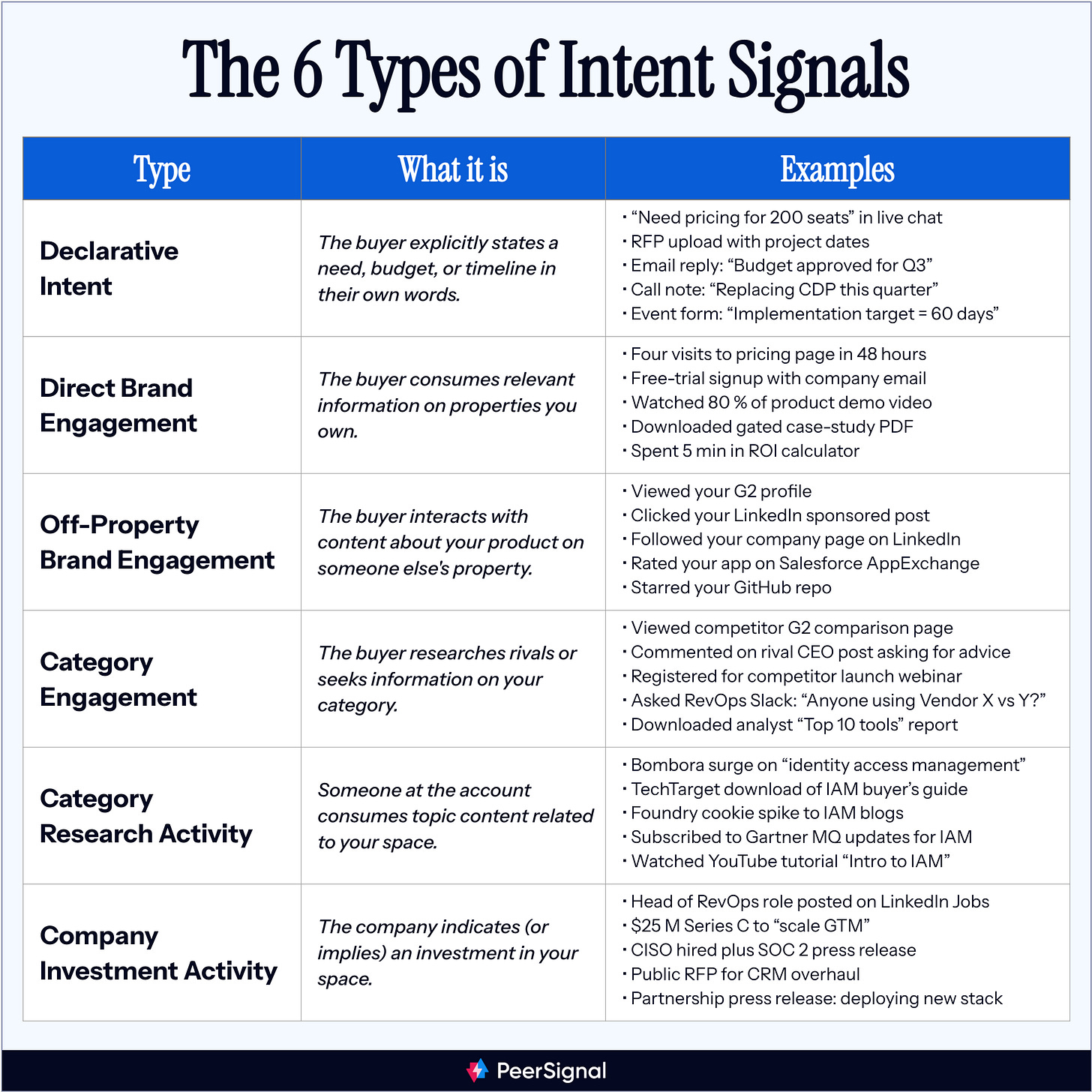WTF is Intent
Beyond the buzzword. 6 practical types.
I've watched dozens of B2B teams spend six figures on “intent” signals only to have their sales teams ignore the leads within weeks.
Every RevOps leader has been here: Sales complaining that marketing's Intent-QLs are going to buy, while marketing insists they're sending over hot prospects.
This post gives you two frameworks to help:
Fit × Intent – the two dimensions of account selection. Remember, intent ≠ ICP.
The Six Intent Types – a detailed breakdown of the buzzword.
I will not spoon-feed you a “playbook” or give you a 72-column Clay table you can copy (if you comment on LinkedIn). My goal here is to outline a practical framework that might help you decide on the right approach to “intent” for your strategy.
How Intent Helps
It makes good sense to select and segment accounts on two high-level ideas – fit and intent. You can think of this in a simple 2x2 matrix:
Fit is structural. It’s the foundation for ICP targeting.
Intent is temporal. It drives timing and approach within your ICP.
Understand timing is important for two reasons
With limited resources, you’d put more effort and spend on the “Right-Now Revenue”
You’d approach these buckets differently.
The biggest trap with intent is to skip fit. This is the problem with some of the legacy ABM platforms – they sell what I call “WTF-Intent-QL” programs. Time-Wasters “count” as qualified leads while sales is asked to pursue poor-fit accounts.
Fix Fit first, then layer intent. Start with an ICP definition (frameworks here) and then translate to an ICP model (frameworks here).
To add the intent dimension, you’ll want to think in terms of 6 types of intent.
The Six Intent Types
The trap is to frame these in terms of a vendor’s perspective. I.e. You start shopping for 1p, 2p, and 3p data tools. Instead, you can start with signals, and work backwards to tools:
These categories aren’t exhaustive. This is meant as a starting point for you to build your own frameworks.
The best Strategic RevOps teams we work with build out dozens of unique and specific intent signals and run coordinated, signal-based GTM plays towards those accounts.
This allows them to run more specific messaging, to better accounts. And they can use this data to understand what plays are working and why, so they can consistently get smarter and more efficient.
Signals First, then Tech
“Skip the strategy, buy the platform” never works.
Once they have clarity on which signals they care about, they then seek out tools that can help.
Once they validate that signals work, they double down and invest further, not the other way around.
We’ve identified lots of ways to get these intent signals that are NOT a $200k “ABM Platform”.

How to Avoid the WTF-Intent-QL
The smartest Strategic RevOps leaders understand that intent is more like a collection of clues. And they get clear on which clues they care about, why, and how they’ll action them. They:
Decide which intent signals they care about. Can start with these 6 categories. Different for every business.
Prioritize by breaking accounts into 4 buckets with the Fit x Intent matrix. So they don’t waste spend and energy in never-never land. They route by quadrant.
Right-Now Revenue → SDR plus AE, same day.
Future Deals → nurture and watch.
Time-Wasters and Never Never Land → ignore.
Prove signals by actioning on them and looking deeply at downfunnel metrics by signal.
Improve their account selection by consistently experimenting with new signals to find right now revenue. 9/10 will fail but the winners will “pay back the fund”.
And then (and only then) do they spend on more tooling to accelerate.
I hope this helps you avoid signal overload.
Have any other follow-up questions or feedback? Reply to this email, I’d love to hear from you!







Great post! Thanks for providing clear examples of signal types and platforms to consider.
Couldn't agree more, Intent is a collection of clues, and often it is when you start seeing signals together; it makes all the more sense.
Btw I realised that Developer Software have very different intent signalling and hence we built reo.dev (www.reo.dev) to solve that - do check it out if you get some time :)